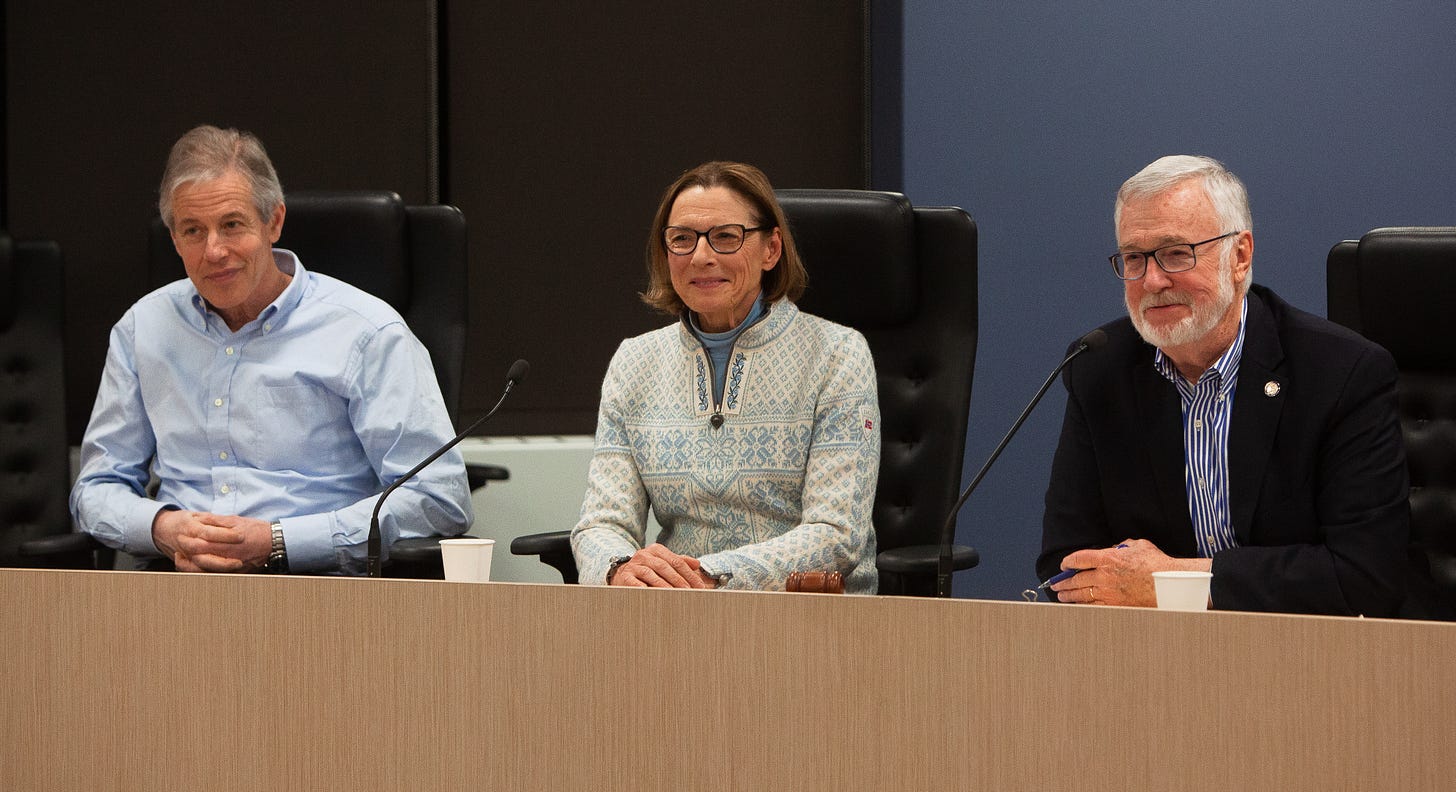Holding the majority comes with a price
The art of demanding compromise without offering compromise.
It’s Monday, Alaska.
In this edition: It’s the day before session and all through the House, not a majority is stirring. Just a lot of rumors. Republicans, on paper, should have the numbers to control the 40-member House but it’s everything that’s not on paper that’s making that difficult. In today’s edition, let’s talk about the cost of a majority and why it might be a difficult compromise for a group that’s adverse to compromise.
Current mood: 🤓
Coming soon: I’m going to be moving into a more regular beat of morning dispatches covering Alaska politics with several deep dives as warranted throughout the week.
Something “fun”: An Alaska miner told Joe Rogan that a museum dumped valuable mammoth tusks into a New York City waterway. Now people are trying to find them.
Holding the majority comes with a price
It’s the eve of the 33rd Alaska legislative session, a year with the largest freshman class since 2003 with 20 brand-new legislators set to be sworn in on Tuesday, and we once again find ourselves without an organized House. There’s been ideas floated and a fair amount of bluffing, but no one commands the 21 votes needed to elect a speaker.
Meanwhile the Senate, which staked out its turf with a 17-member bipartisan supermajority back in December, has laid out an ambitious policy platform for the session, signaling interest in boosting school funding (with strings attached), addressing health care and energy costs and “seeking solutions” for the state’s public employee and teacher recruitment and retention, which could open the door for long-sought changes to the state’s retirement system.
But just how the House organizes—whether it be a Republican-led majority, a Republican-led mostly Democratic majority or a Republican-led bipartisan majority—will go a very long way to deciding just how those issues get decided.
That Republican-led line? Right, that’s the point of this column.
As we talk about ongoing fight over organization, I think it’s important to take a moment to understand just what it costs to hold a majority.
Bipartisan doesn’t mean progressive

The last three legislative sessions have featured mostly Democratic bipartisan majorities, which have all owed their majority status to a handful of moderate Republicans who looked at their increasingly conservative and extreme Republican colleagues and said, “No, thanks.” While those Republicans left in the minority and their allies would have us think that the resulting bipartisan majorities have been lousy with dirty liberal politics, that’s not exactly been the case (with, I suppose, the exception being outlawing child marriage).
What has gone largely unremarked upon in the last six years of House bipartisan majorities is that despite the majority of Democrats among the ranks, the policy outcomes have been generally centrist with those moderate Republicans at many of the levers of power. Yes, that’s simplifying much and overlooking a lot more, but those moderate Republicans have been able to wield a significant amount of power, especially over the budget in the House Finance Committee where they can always team up with the minority Republicans. That’s why we often see those minor end-of-year budget fights decided along partisan, rather than caucus, lines, and it’s why the moderate Republican approach of “PFD cuts before taxes” has been the leading legislative approach to the budget in recent years.
That’s all to say, I think it’s a deal many Democrats were—and would be—willing to make. Whether it be their own moderation or whether it was a bit of pragmatism to avoid the alternative—the alternative being something along the lines of House Judiciary Committee Chair David Eastman—they saw they had to give something up to get a majority and keep committee gavels.
I’m not sure that’s an option for the Republicans who’ve been stewing in the minority, preaching about ideological purity and a rigid unwillingness to compromise. Or, at the very least, it’s not an option without risking further internal fractures between the moderate Republicans (a relative term) and extreme-right Republicans.
The importance of leverage
It’s created an interesting situation for negotiations now. Early on the process of organizing, I had heard a pretty detailed explanation of how the Republicans planned to organize. The big question I had, though, was where the room for was the 21st and 22nd votes when they had already carved up all the choicest jobs—Speaker, Finance co-chairs and everything else—for themselves.
The problem, of course, is the moderates willing to break ranks with the bipartisan coalition to gift the Republicans a majority hold an incredible amount of leverage—just as the moderate Republicans joining the bipartisan majority did.
It’s the sort of leverage that they could use to ensure key priorities like the Alaska Marine Highway System, Power Cost Equalization and local oil and gas property taxes are protected as well as play a key role in shaping whatever policy position the House takes on issues like school funding or the retirement changes. It’s the sort of leverage that gets turned into a co-chair of Finance or the Speaker’s gavel, and therefore an incredible amount of power to shape—and, potentially, rein in—the agenda.
Those are concessions I’m not sure the Republicans—or at the very least, all the Republicans needed to keep this thin majority together—would be willing to make.
And that puts them into a difficult position, especially given just how prone to infighting its membership has become. It sounds like Rep. David “Twice Kicked Out of the Republican Caucus for Not Playing Nice” Eastman is already on the outs, but Eastman was just the most extreme of his kind in the Legislature. It’s entirely possible some Republicans would rather revolt than hand over a plumb post to bipartisan House Speaker Louise Stutes or, gulp, an independent.
The more the merrier

Perhaps the clearest example of what it takes to achieve a bipartisan majority can be seen with the Senate’s supermajority. The 17-member supermajority is, in many ways, a direct continuation of the supermajority that controlled the Senate the last time the Senate was a bipartisan chamber. The players have changed, some of the same players have changed roles (Sen. Cathy Giessel going from super-minority member to supermajority leader), and moderate Kodiak Republican Gary Stevens is once again assuming the role as Senate President.
And then, like now, one of the best ways to explain a majority this big and politically diverse is they avoid polarizing issues on either side of the spectrum—that’s why legislators are already declaring abortion-related legislation of any kind is a non-starter this year—while trying to find some common ground on the common ground.
Like with the House’s thin, Republican-led majorities, the end result is a more centrist platform. It means anti-trans bills won’t get traction, but it also means anti-discrimination legislation will likely wither (as it did during the last six years).
The reality is without a critical mass of votes—especially without an agreement to vote for the budget—it’s difficult if not impossible to govern with much partisanship.
Whether the House Republicans understand that or whether they continue the untenable strategy of demanding compromise without offering compromise will be the deciding factor in just how the House ultimately organizes… and when it organizes.
As one legislator told me, we won’t really know for sure until the vote for speaker is finally called.
The House is scheduled to convene at 2 p.m. on Tuesday. (And the Senate’s at 1 p.m.)
One more thing…
As a sidenote, the last year that Sen. Gary Stevens was Senate President Gary Stevens was my first year covering the Alaska Legislature. To me, a kid who had just six months prior been writing about neighborhoods in Portland, Ore., the concept of a bipartisan legislative chamber seemed unthinkable. But there it was, a bunch of Democrats and Republicans uneasily sharing power, approving what would be the state’s last big-time capital budget for a while and getting into it with the House on oil taxes.
It was a crash course and a half, and it showed me just how unusual and intriguing Alaska’s politics can be. It’s probably also a big part of why I’ve been doing this for more than a decade.
Stay tuned!






I’m curious as to the tone that the incoming freshman representatives will bring to the chambers. Will what’s her face Allred from Eagle River continue with her Tour Obnoxia in Juneau? Who, if anyone, will curb her?